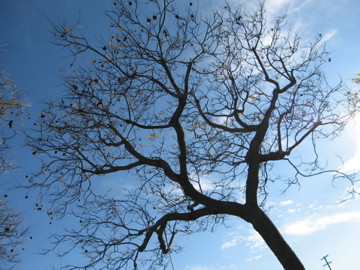Let’s talk about when to plant that tree of yours!
One of the most asked questions I get wherever I am running around town is “Jimmie, when is the best time to plant a tree?” Depending on how I running on time that day I can give the short answer or the long answer.
In general, the best time for planting trees is mid fall to early winter or early spring. If that doesn’t fit your schedule, then aim for autumn. Summer’s a bad choice, because the weather’s too hot and the actively growing plants too susceptible to damage. Weather also restricts your options in the late winter because the cold causes the ground to freeze. If you’ve had the foresight to do all your digging ahead of time (before the ground freezes), it’s not impossible to plant trees in winter. But unless you can water them sufficiently late winter is not the best planting time, either.
Trees in a Dormant phase:
When to Plant Trees That Are Deciduous
In a way, the best time to install deciduous types is more obvious. The dropping of their leaves in autumn signals that they are entering dormancy. The unfurling of buds in spring signals that they are leaving dormancy.
You have more leeway in the matter of when to plant trees that are evergreen. You can undertake the operation earlier in the fall and later in the spring than their deciduous counterparts. However, you’ll still want to avoid planting them when it’s hot. If it’s still hot in late September, hold off till later in the fall. Likewise, it gets pretty hot here by June so plant those evergreens earlier in the spring!
When to Plant Trees: A Follow-Up Consideration
Intense heat is a major enemy to newly planted saplings. But lack of water for their root systems is another. And although you may not think of winter as a dry time due to cooler temperatures most of our trees will still require about an inch of water per week year round! That’s why watering trees properly in fall is important — regardless of whether you’ve opted for planting in autumn or in late winter / early spring.
Question: Jimmie, thanks for your wonderful columns! I so enjoy reading them and really learn allot from your years of wisdom. I am thinking of buying a new tree for my backyard and I spoke with a tree farm on the phone and the first question they asked me was I okay with a B&B tree?? I immediately thought, “what the heck is that?” So I figured I better ask you before I went any further! Thank you again for your time and help! Minnie C. in Prosper
Answer: Hi Minnie, thanks for the kind words!
A Balled and burlapped plants are transplants shipped to the consumer after having been planted, dug up and wrapped. “Balled” refers to the root ball which has been dug up, while “burlapped” refers to the wrapping material traditionally used for transporting tree and shrub deliveries. The burlap is secured with string, wire or twine. When purchasing balled-and-burlapped plants, ask if the burlap has been treated to be rot-resistant. Anything not biodegradable needs to be removed when planting (e.g., wire and rot-resistant burlap).
These can also be known as (B&B, Balled in Burlap or Ball and Burlap)
Your best (but more expensive) trees purchased from a grower would be “Container Grown”. Those would have all the roots the tree has had its entire life and has the best chance at surviving in its new home (your backyard)!!
Question: Jimmie, I had a young man stop by my house the other day and advised me to do some tree work out front to my trees and claimed he was a arborist. I figured if anyone would know how to check this man out it would be you. Is there somewhere you know about to follow up on this guy to make sure he is legit? Thank you so much for your time! Jennifer H. in Prosper
Answer: Hi Jennifer, Arborists are professionals who practice arboriculture. They are knowledgeable about how trees grow and how to take care of tree problems that homeowners may experience.
Before hiring arborists, check to ensure that they are certified. While this will not guarantee the desired outcome, at least you are starting the project with someone “a cut above” the sort of jack-of-all trades who may offer to do the work for less money — but who may only exacerbate the problem. Certified arborists are accredited by the International Society of Arboriculture. Until next time…Happy Gardening!!

